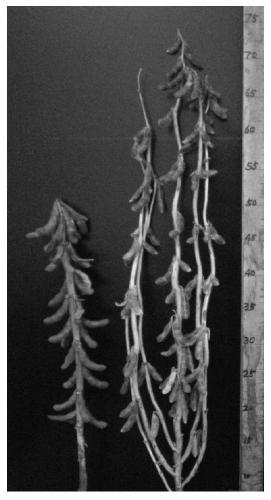Soybean branch number molecular marker and application thereof
A technology of molecular markers and molecular marker sequences, which is applied in the field of biotechnology and genetic engineering, and can solve the problems of complex soybean genome and genetic structure
- Summary
- Abstract
- Description
- Claims
- Application Information
AI Technical Summary
Problems solved by technology
Method used
Image
Examples
Embodiment 1
[0052] A soybean molecular marker, the soybean molecular marker includes: a DNA molecule obtained by using soybean genomic DNA as a template and using primers to amplify BR69; and, using soybean genomic DNA as a template and using primers to amplify BR77 DNA molecule.
[0053] The BR69 primer pair includes:
[0054] BR69-F: 5'-AGTTGACAGGAACTAAAGT-3', as shown in SEQ ID NO.1;
[0055] BR69-R: 5'-GATAATTCAAGTAAATAGCGA-3', as shown in SEQ ID NO.2;
[0056] The BR77 primer pair includes:
[0057] BR77-F: 5'-TCTCTTTGTGTATGTCTTTCTCC-3', as shown in SEQ ID NO.3;
[0058] BR77-R: 5'-TTGTTGCATCCAAATGAGAG-3', as shown in SEQ ID NO.4.
[0059] Wherein, in DNA molecule a, the soybean molecular marker sequence of KF19 is:
[0060] ATTTTTTTATTGAATAAAATCAAAATAATCCTATTTTTAAAAACTAAAATTAAGTCTTTTTTTTTACATGCTAGTTAAAGTAATACTTAAGTTTATAACTTTATTAACCTTTTCATTTTTACTTATTGATGTAATCTCTTTTTATATA, as shown in SEQ ID NO.5;
[0061] In the DNA molecule a, the soybean molecular marker sequence of KN24 is: ...
Embodiment 2
[0091] The method for assisting the identification of soybean branch number establishment is as follows:
[0092] Extract the genomic DNA of the soybean to be tested, and use the genomic DNA as a template to perform PCR amplification on BR69 and BR77 using primers (PCR reaction program: 95°C 5min; 95°C 30S, 55°C 30S, 72°C 30S, 35 cycles ; 72°C for 10 min.), followed by 6% non-denaturing polyacrylamide gel electrophoresis and silver nitrate staining. Then make the following judgments:
[0093] Using the genomic DNA of the soybean to be tested as a template, use the specific primers BR69 and BR77 to carry out PCR amplification to obtain the length of the PCR product. If the PCR product of BR69 is 156bp and the PCR product of BR77 is 268bp, then the PCR product to be tested The number of branches of soybean is multi-branched or the candidate is multi-branched; if the PCR product of BR69 is not 156bp or the PCR product of BR77 is not 268bp, the number of branches of the soybean t...
Embodiment 3
[0094] Embodiment 3 identifies F7 population and soybean branch number according to the method established in embodiment 2
[0095] The actual number of branches of each individual plant in the constructed Kennong 24 / Kenfeng 19F7 population was recorded, and the experimental results are shown in Table 2. Randomly get 30 multi-branched individual plants and 30 less-branched individual plants, and identify them according to the method established in Example 2. Electrophoresis after PCR amplification of BR69 using primers figure 2 with image 3 ( figure 2 Middle A is the electrophoresis image of 30 multi-branched single plants, in which lanes 1 to 30 are multi-branched single plants numbered 1 to 30, lane 31 is Kennong 24, and lane 32 is Kenfeng 19; image 3 Middle B is the electrophoresis of 30 less-branched individuals, in which lanes 1 to 30 are the less-branched individuals numbered 31 to 60, lane 31 is Kennong 24, and lane 32 is Kenfeng 19). Electrophoresis after PCR a...
PUM
 Login to View More
Login to View More Abstract
Description
Claims
Application Information
 Login to View More
Login to View More - R&D
- Intellectual Property
- Life Sciences
- Materials
- Tech Scout
- Unparalleled Data Quality
- Higher Quality Content
- 60% Fewer Hallucinations
Browse by: Latest US Patents, China's latest patents, Technical Efficacy Thesaurus, Application Domain, Technology Topic, Popular Technical Reports.
© 2025 PatSnap. All rights reserved.Legal|Privacy policy|Modern Slavery Act Transparency Statement|Sitemap|About US| Contact US: help@patsnap.com



